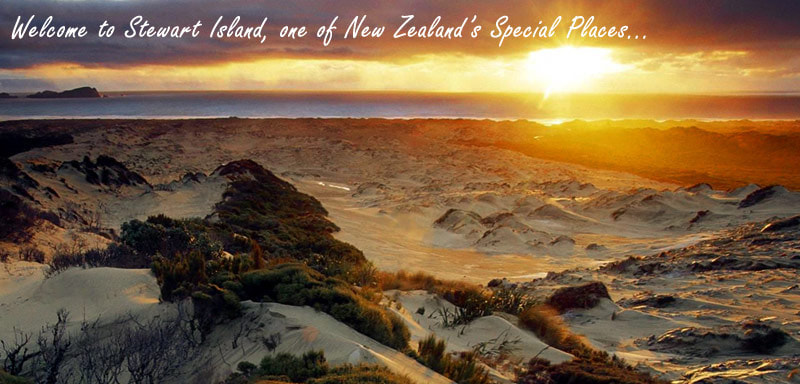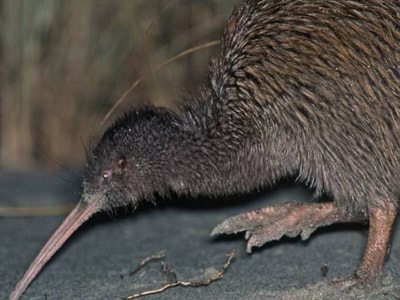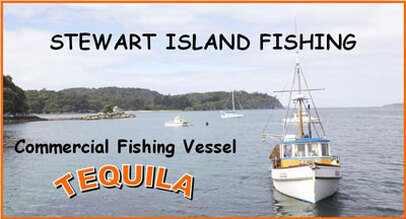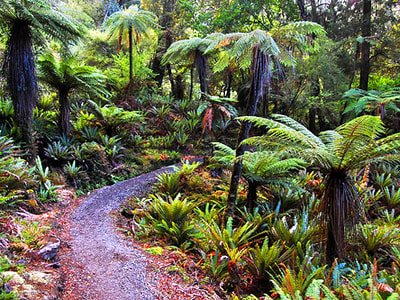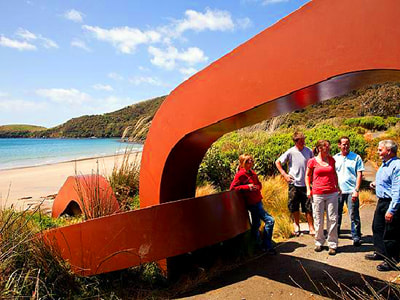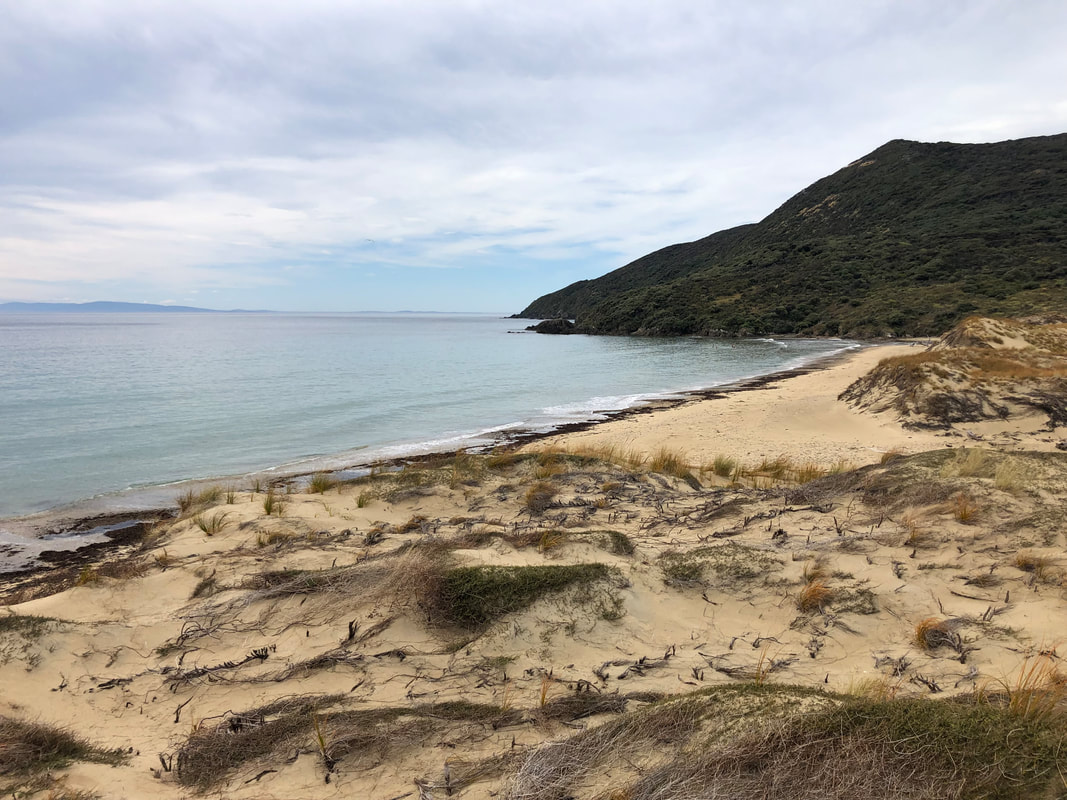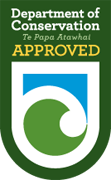Stewart Island Information
Stewart Island/Rakiura is home to New Zealand’s most southern and newest national park, Rakiura National Park. Rakiura, translated as "The Land of Glowing Skies", probably refers as much to the night-time displays of Aurora Australis, the Southern Lights, as to the sunsets. The island has had at least two other Māori names. Te Puka a te Waka a Māui (The Anchor of Māui’s Canoe) refers to the tradition of Māui’s discovery of New Zealand and his use of the South Island as a canoe or platform by which he fished up the North Island. Stewart Island/Rakiura anchored his canoe. The island was also known in early times as Motunui (Large Island). The main settlement is situated in Halfmoon Bay and has a general store, postal agency, Department of Conservation Visitor Centre and various accommodation options. From Halfmoon Bay there are a number of tracks suitable for day walks.
Features of Stewart Island
From the South Island Stewart Island can be seen on most days as a mysterious jagged, dark blue landscape on the horizon. When the weather drives in from the Southern Ocean the island disappears behind low cloud and grey sheets of cold rain. On clear summer days the island seems very close and shines an inviting blue-green, topped by rocky mountain peaks.
Rakiura National Park on Stewart Island, the 14th of New Zealand's national parks, opened in 2002.
The park covers about 157,000 hectares and makes up about 85 percent of the island. It encompasses a network of former nature reserves, scenic reserves, and state forest areas. Although the island lies only 30 kilometres south west of Bluff, between latitudes 46 and 47 degrees south, it could well be in another part of the world.
The people here are a little less hurried, much more friendly and a great deal more self-reliant than people in most other places. The little community of 400 or so permanent residents in the only settlement, Oban in Halfmoon Bay has a school, a quaint hotel, two small churches overlooking the harbour, good shops for basic necessities, a well equipped visitor centre and a number of tourist services. A new community centre, which houses a library and an indoor sports stadium, has recently been completed following several years of determined fund raising by islanders.
Many residents are direct descendants of the whalers and early Rakiura Māori, with combined family histories reaching back almost 200 years. Some of the houses built by the early Norwegian whalers are still lived in today, their distinctive alpine architecture somehow no longer out of place in the Roaring Forties of the Southern Ocean.
Rakiura National Park on Stewart Island, the 14th of New Zealand's national parks, opened in 2002.
The park covers about 157,000 hectares and makes up about 85 percent of the island. It encompasses a network of former nature reserves, scenic reserves, and state forest areas. Although the island lies only 30 kilometres south west of Bluff, between latitudes 46 and 47 degrees south, it could well be in another part of the world.
The people here are a little less hurried, much more friendly and a great deal more self-reliant than people in most other places. The little community of 400 or so permanent residents in the only settlement, Oban in Halfmoon Bay has a school, a quaint hotel, two small churches overlooking the harbour, good shops for basic necessities, a well equipped visitor centre and a number of tourist services. A new community centre, which houses a library and an indoor sports stadium, has recently been completed following several years of determined fund raising by islanders.
Many residents are direct descendants of the whalers and early Rakiura Māori, with combined family histories reaching back almost 200 years. Some of the houses built by the early Norwegian whalers are still lived in today, their distinctive alpine architecture somehow no longer out of place in the Roaring Forties of the Southern Ocean.
Things to do and see
Native birds that may be seen during these walks include parakeet/kākāriki, native wood pigeon/kererū, tūī, bellbird/korimako, tomtit/miromiro, weka, robin/kakaruai, and fernbird/mātā, as well as a significant population of South Island kākā.
The island's kiwi population is also special. Known now as southern tokoeka, the Stewart Island kiwi behave rather differently to kiwi in other parts of New Zealand. They maintain family groups, for example, and some birds feed during daylight hours. Stewart Island offers perhaps the best opportunity anywhere in New Zealand for viewing kiwi in the wild.
The island was the final stronghold for the flightless, nocturnal parrot/kākāpō, which had all but disappeared from the mainland under pressure from stoats and other predators leaving less than a hundred birds in Fiordland and Stewart Island. The last 60 or so birds were relocated to nearby Whenua Hou or Codfish Island which is now a nature reserve supporting other endangered species.
This pest-free island is excluded from the park, as is all Māori land, freehold land and the foreshore.
White-tailed and red deer, cats, and rats introduced in the early 1900s, together with possums, have had an impact on the forest, shrublands, herbfields and native fauna.
The island's kiwi population is also special. Known now as southern tokoeka, the Stewart Island kiwi behave rather differently to kiwi in other parts of New Zealand. They maintain family groups, for example, and some birds feed during daylight hours. Stewart Island offers perhaps the best opportunity anywhere in New Zealand for viewing kiwi in the wild.
The island was the final stronghold for the flightless, nocturnal parrot/kākāpō, which had all but disappeared from the mainland under pressure from stoats and other predators leaving less than a hundred birds in Fiordland and Stewart Island. The last 60 or so birds were relocated to nearby Whenua Hou or Codfish Island which is now a nature reserve supporting other endangered species.
This pest-free island is excluded from the park, as is all Māori land, freehold land and the foreshore.
White-tailed and red deer, cats, and rats introduced in the early 1900s, together with possums, have had an impact on the forest, shrublands, herbfields and native fauna.
Kiwi Spotting with Wild Kiwi Encounter
|
Few visitors to New Zealand have the chance to see the Kiwi, New Zealand's iconic native bird, in the wild. Phillip Smith has been operating Kiwi Spotting tours on Stewart Island for over 20 years. Don't miss this unique opportunity to see the Stewart Island Brown Kiwi.
Click the button below for more information on Bravo Adventure Cruises. |
Stewart Island Fishing
|
Be part of the crew and join us for a unique Fishing Experience on the Commercial Fishing Vessel TEQUILA, while taking in the spectacular surroundings of the Roaring 40s.
We will demonstrate how to prepare, set and retrieve Cod Pots and how to process the Catch once landed (i.e. sorting, ikiing, filleting). Using traditional Hand Lines, you will be able to catch your own Blue Cod to take home. Click below for more information on Stewart Island Fishing. |
Take a Great Walk on The Rakiura Track
|
The Rakiura Track is one of New Zealand's Great Walks. 30 km of tramping track traverses country with a rich diversity of trees, ferns, and perching orchids. Suitable for anyone with moderate fitness, the entire circuit is actually 37 km in total, including road walking. It takes three days, provides a good introduction to the scenery of Stewart Island and is suitable for tramping all year round. Along the way visit historical sites with the chance to see a variety of sea and forest birds.
Click the button below for more information about the Rakiura Track. |
Transport Options
Explore the Village and Bays with Stewart Island Experience
|
Whether it be a quick shuttle, a full tour of Oban or a Water Taxi, Stewart Island has the transport options for you...
Explore the Village and Bays with Stewart Island Experience. Explore Oban and the surrounding bays in our modern mini-buses. Our guides enjoy sharing their local knowledge of the history and environment of Stewart Island. Gain an entertaining insight into New Zealand’s southernmost community. Stewart Islanders are proud of their island, enjoying its simpler, slower pace. During your tour, there is plenty of time available for photo stops and short walks. Highlights include Lee Bay, the gateway to Rakiura National Park; beautiful Horseshoe Bay and stunning views of Paterson Inlet from Observation Rock. Click the button below for more information on Stewart Island Experience. |
Take to the water with Stewart Island Water Taxis
|
If you are looking for adventure, need transport to a hunting block or want to watch birds, there are options that can help you explore beautiful Stewart Island. Guided nature tours and water taxi packages can be provided.
Offering Water Taxi Transport to Ulva Island Bird Sanctuary, Freshwater River, Coast to Coast, Port William or Christmas Village. Click the button below for more information on Stewart Island Water Taxis. |
